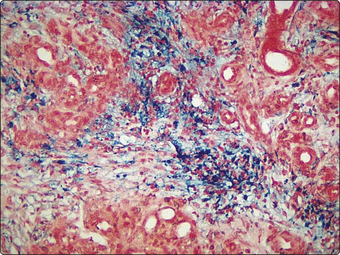Chapter 12 Abnormal pigment deposition
Haemosiderin
Localized haemosiderin deposition occurs in inflamed tissues from the breakdown of haemoglobin in extravasated red blood cells. The haemosiderin is taken up by macrophages (Fig. 3.12.1). The presence of this pigment is used by pathologists as an indicator that inflammation has occurred, and it may be mentioned in histopathology reports for this reason.

Fig. 3.12.1 Haemosiderin deposition in chronic inflammation. The Perls stain turns the haemosiderin blue.
Only gold members can continue reading. Log In or Register to continue
Stay updated, free articles. Join our Telegram channel

Full access? Get Clinical Tree







